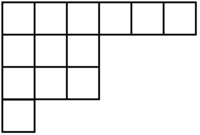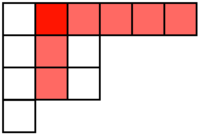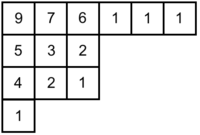Difference between revisions of "Hook Length Theorem"
(→Theorem) |
(hook number for upper right squares are wrong not 1,1,1 its 3,2,1) |
||
| (One intermediate revision by one other user not shown) | |||
| Line 20: | Line 20: | ||
[[File:TableauHook.png|200px|center]] | [[File:TableauHook.png|200px|center]] | ||
| − | So in the example, the number of SYTs is <math>\frac{13!}{9\times7\times6\ | + | So in the example, the number of SYTs is <math>\frac{13!}{9\times7\times6\times3\times2\times1\times5\times3\times2\times4\times2\times1\times1} = 11440</math>. |
Latest revision as of 16:02, 19 April 2023
Introduction
The hook length theorem is a theorem to be used on Standard Young Tableau. A standard Young Tableau is essentially a pack of blocks together, such as this one:
A tableau has a decreasing(not strictly decreasing) number of blocks in every row.
A Standard Young Tableau(SYT) has increasing numbers in both rows and columns. As shown in the figure, 1-3-10 is increasing, as well as 2-5, 4-6, 7-9, 1-2-4-7-8, and 3-5-6-9.
Theorem
Let the number of blocks in the tableau be n. A hook of a block is the number of blocks to the right and below the block, including the block. In the below image, the hook of the red square is ![]() .
.
Let the product of all the hooks in a tableau be ![]() . Then, the Hook Length Theorem states that the number of SYTs is
. Then, the Hook Length Theorem states that the number of SYTs is ![]() . The number of hooks of each block in the example tableau is shown below.
. The number of hooks of each block in the example tableau is shown below.
So in the example, the number of SYTs is ![]() .
.













